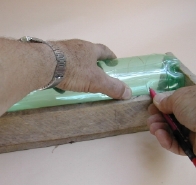Some Construction Technics
Cutting of bottles
Whether we have to cut a sleeve, a cone, a bottle neck or a fin skirt, cutting bottles is not easy if we do not have a minimum of technique.
The main difficulty is due to the flexibility of the material, to overcome this, it suffices to inflate the bottle to 2 or 3 bars so that it becomes rigid. To do this, use a plug pierced in its center by an 8 mm hole in which a bicycle inner tube valve will be placed, as shown in the diagram below.

At this time, we can draw the guide lines for cutting. If you want to make several cuts on the same bottle, you will have to trace everything first since the first cut, the bottle will deflate.
To draw a circular cutting line on a plane perpendicular to the axis of the bottle, 2 methods (at least) are possible:
 Take
a sheet of A4 paper and wrap it around the bottle making sure it forms a
perfect cylinder. To do this, place the short side of the sheet in the
axis of the bottle (we will help the marks due to the molding joint),
one of the long sides being positioned at the location of the line to be
drawn. Roll up the foil so that it fits snugly on the bottle. When you
have gone around the bottle, the 2 ends of the long side of the sheet
should be aligned. Secure the sheet in position with duct tape. It is
then sufficient to follow the edge of the sheet to trace.
Take
a sheet of A4 paper and wrap it around the bottle making sure it forms a
perfect cylinder. To do this, place the short side of the sheet in the
axis of the bottle (we will help the marks due to the molding joint),
one of the long sides being positioned at the location of the line to be
drawn. Roll up the foil so that it fits snugly on the bottle. When you
have gone around the bottle, the 2 ends of the long side of the sheet
should be aligned. Secure the sheet in position with duct tape. It is
then sufficient to follow the edge of the sheet to trace.

Use the trace box described in the Material page. Position the bottle, the neck (or the bottom) against the side board. Position an indelible marker against the bottle at the location of the line to be made and leaning on the side of the box. Roll the bottle to trace.
To draw a line parallel to the axis of the bottle, use an angle iron as shown in the photo below

Once the tracings are completed, we move on to cutting.
Take a sharp cutter, and make a first pass without pressing too much to mark the groove. To be done on each cut line.
Then pass again by pressing a little more. Be careful, when the blade pierces the plastic, the bottle will deflate quickly, don't be surprised.
For the other cuts, the bottle can no longer be inflated, so we will use a cleat, also described in the Material page, to make our work easier.
 Secure
this cleat in a vise or workbench, as opposite. All you have to do is
slide the bottle onto this cleat and use it as a cutting support. We
will proceed by small cut with the width of a cleat, then we turn the
bottle a little, we continue the cut on the width of the cleat, and so
on until having made the complete turn of the bottle.
Secure
this cleat in a vise or workbench, as opposite. All you have to do is
slide the bottle onto this cleat and use it as a cutting support. We
will proceed by small cut with the width of a cleat, then we turn the
bottle a little, we continue the cut on the width of the cleat, and so
on until having made the complete turn of the bottle.
For longitudinal cuts, no problem, a good pair of scissors will do.


